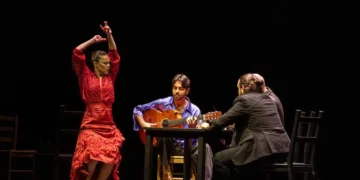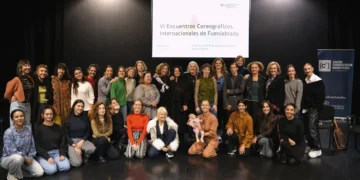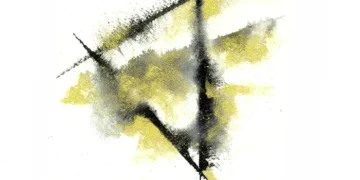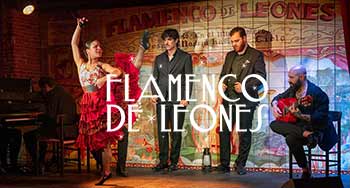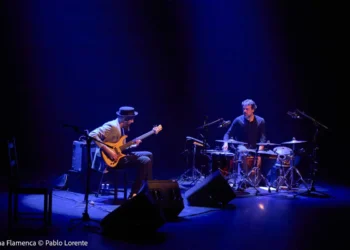|
| Coverage of the Thirteenth Festival Flamenco Caja de Madrid is sponsored by Arte Fyl Dance Shoes |
| Calzados de Arte Fyl: art for the Art Professionals know |
TWO CENTURIES OF FLAMENCO IN THREE
HOURS
1 part: “Clásicos de puro arte”. Cante:
José de la Tomasa and José Menese. Guitar: Manolo
Franco and Enrique de Melchor
2 part: “Flamenco contemporáneo”
Piano: Chano Domínguez; Bass: Mario Rossy; Percussion: Marc
Ribalta; Cante: Blas Córdoba “Kejío”;
dance and palmas: Tomasito.
Text: Manuel Moraga
The bill of artists was made up to hinge, somewhat dangerously,
on a 180º turn between the first and second parts. The “Clásicos
de puro arte”, the first offering of the night, was able to
congregate an audience of diametrically opposed taste to that of
the second half, “Flamenco contemporáneo”. However
the final result was enriching for most of those who attended. The
pleasure of “surprise”, quote unquote, had a lot to
do with it.
José de la Tomasa and José Menese were the “classics
of pure art” referred to in the title. Maestros both of them,
and references for today’s flamenco artists. Furthermore,
with de la Tomasa there was a certain sense of expectation, as his
visits to Madrid are fewer than many of us would like. He was up
to the challenge, but without reaching his customary heights. In
a certain sense, this was the first surprise.
José de la Tomasa broke the ice of the night and the festival
with a ‘caña’, in honor of Rafael Romero ‘El
Gallina’. To his left, guitarist Manolo Franco. The Seville
singer personalized the cante and followed with a set of alegrías
that brought him to two of his most interesting palos: soleá
and siguiriya. In these cantes he warmed up and started to communicate,
achieving some truly powerful moments in which it must be noted
that the guitarist contributed a great deal. He ended up with a
set of quality bulerías that included one verse in memory
of María la Perrata who died just days ago.

Perhaps it was his voice that limited José’s possibilities.
Only now and again did he manage to crank out that clean, sharp
instrument he normally uses to reach audiences. Even so, his modulations
(José’s voice is a force to be reckoned with, even
in less than top form), command and gypsy way with the cante are
sufficient reasons to enjoy this maestro’s art.
An aura of uncertainly seemed to precede Menese. In nearby bars
outside the Albéniz theater, there were voices of doubt regarding
the singer from La Puebla de Cazalla. And that was the second surprise
of the night. “Surprise” with lots of quote marks because
the fact that Menese would offer a great concert shouldn’t
surprise anyone at this stage of the game. He opened with tientos
followed by caracoles, and the petenera brought him good fortune,
(contrary to the taboo surrounding this cante), for the soleá
and, in particular, the siguiriya.
Powerful singing, fighting every inch of the way, relentlessly
seeking and pushing out each tone. From the first moment, Menese,
with the greatness that characterizes his cante, stilled all doubts.
Unembellished cante that made no concessions, cutting straight to
the truth of each line of each verse. Hard, straightforward and
deeply felt cante (the warm-ups for soleá and siguiriya are
still ringing in my head). At one point a member of the audience
called out “thank you José!”. Most of us present
harbored the same sentiment. Menese represents a school of cante
that has few followers these days. Enrique de Melchor accompanied
the singer and backed him up with his customary skill. A true example
to follow.

After intermission, with Menese’s good impression still lingering,
came the challenge: how many people would manage to cope with such
a radical about-face? The ones who stayed had nothing to regret.
Chano Domínguez is one of the most popular musicians in
Spain. That flamenco should be one of his creative references is
a privilege for our art. If José de la Tomasa and Menese
are grand representatives of an aesthetic that accents the classic
forms, the pianist from Cádiz is the perfect example of how
to draw rich music from those very same forms and, unabashedly adapt
them to the most contemporary of musical forms: jazz.
From the very first compases of alegrías he submerged the
audience in a musical ambience that was tremendously rich in rhythm,
phrasing, harmony, mood…everything. Some people simply walked
out, even in the middle of numbers, demonstrating an absolute lack
of respect for the musicians and the rest of the audience. But most
stayed. Most likely a large number of those who had come for “Clásicos
de puro arte” wanted to have a peek at the second half, just
out of curiosity, and then leave. But not all of them did that,
and herein lies the unexpected element of the night: they stayed,
and no one was forcing them to do so. In the end, sensitivity and
good taste in music are not things that need attached labels in
order to be recognized…fortunately.

With an exceptional group of musicians, Chano knew how to take
us from the most delicate moments to the heights of drama, almost
without our realizing it. His sounds continually criss-crossed the
Atlantic, impregnated with that special aroma that comes from the
rhythmic structures of our flamenco art. Tomasito’s flamenconess
was noteworthy as well. Seeing him work the compás is quite
a thing to behold. To see him dance, a delight. At the end, Chano
Domínguez and his excellent group triggered the warmest applause
of the night.
Some of us expected José de la Tomasa to be in better form.
Others thought Menese would be worse. And few people were expecting
that the most vibrant element of the evening would be provided by
Chano Domínguez. That’s the pleasure of “surprise”.
One thing is certain, the final impression we took home afterwards
was one of having covered a distance of two centuries in just three
hours.
Photos by Rafael Manjavacas
|
José Menese |
|
José Menese |
|
José Menese – 21 cantes (1963 -1975) |
|
Chano Dominguez |
|
Chano Domínguez – 1993-2003 (2 CD) – |





